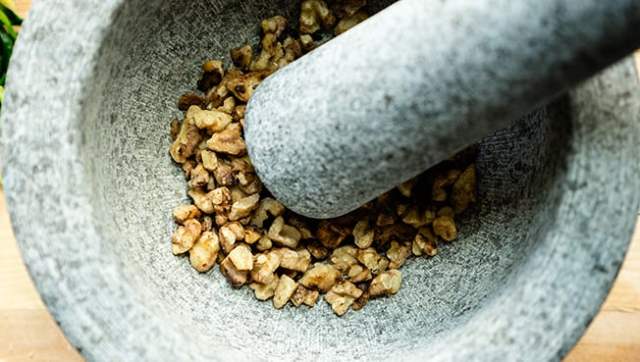Wild Ramp Pesto

Spring has sprung here in the bluegrass state. Sunshine, mild temperatures, and glints of green are a welcome reprieve from the dark and monochromatic days of winter. Getting out of the house to hike and fish is a shot of dopamine. My quintessential dad bod needs all the help it can get after my winter hibernation. I’d be lying if I told you just getting out and getting some endorphins pumping was my only motivation. While out on my walkabout I get to forage for one of my favorite foods, wild ramps. When in season I use ramps in a variety of recipes but this wild ramp pesto is one of my old standbys.
What are Ramps?
\What exactly is a ramp you may be asking? It’s a wild onion that tastes like it’s been mixed with garlic. They range from northern Georgia up into Canada. They grow the best at higher altitudes under deciduous forest canopies in a rich loamy soil. Their growing season generally lasts from early April to around mid-May depending on where you live. As the temperatures start to warm the leaves die off. The window for locating these lush leeks is pretty small so I generally try to get out into the woods as much as I can during this time of the year. Once they are gone you have to wait till next Spring.

Sustainability
In recent years ramps have started to become popular with chefs and foodies. This means demand has skyrocketed and it’s putting pressure on their numbers. They are slow to propagate so if you overharvest they are not able to bounce back the next year. If you decide to get out and forage for ramps, I highly recommend you take less than a third of the patch you find. Sustainably harvest by cutting off the top part of the bulb and leaves while leaving the roots in the ground. This will help ensure they are available for years to come. I generally only harvest a small amount because a little goes a long way. If you strike out in your search, ask around your local farmer’s market. I’ve also seen quite a few for sale on the Facebook marketplace. When you go to purchase them ask how they were harvested. If they still have the roots attached you know they were just yanked out of the ground. No Bueno.

So many choices
So you’ve got your ramps, now what? Well, there are several great options. Any dish that needs onions and garlic can substitute with ramps. Pickling, dehydrating, and fermenting are all great uses for this wonderful plant. One of my favorite ways to use the ramps is to make a ramp pesto. I simply substitute ramps for the traditional basil. It makes a fantastic condiment for just about any protein you can think of. I like to kick off spring by smearing this on everything in sight. It’s a fantastic substitute for the spicy butter in my Grilled Oysters with Habanero Butter recipe if my family is looking for something a bit milder.
Ramp Pesto: Mise En Place
There are relatively few ingredients in this simple but tasty ramp pesto recipe. You’ll need the following: One good-sized bunch of ramps, roughly two cups. 1/3 cup of chopped walnuts 1/2 cup of parmesan cheese. 1/3 to 1/2 cup of extra virgin olive oil. The amount is going to vary based on your personal preference in the consistency of the pesto. 1/2 tsp of lemon juice, salt, and pepper to taste.

First things first
Start by making sure your ramps are clean and washed of any dirt and debris that might still be stuck on them. We are going to get a small pot of boiling water and blanch our ramps for 10 seconds. This is going to help keep the pesto nice and green while it’s in the fridge. Those Instagram photos certainly look a lot better in vivid green than an unappetizing brown paste. After the quick 10 second blanch, dunk the ramps in an ice bath to stop the cooking process. While the ramps are cooling off let’s break out a skillet and toast our walnuts. On medium heat stir the walnuts around for one or two minutes. They are done when the color is a nice golden brown and you can smell that toasted nutty fragrance filling up your kitchen.



On that Grind
After toasting, grind them up. I’m using a mortar and pestle but you can use a food processor if you like. I personally just like the texture a mortar and pestle give you. After the walnuts are a nice chunky paste we can add our ramps and parmesan cheese. Make sure you squeeze all the water from your ramps before incorporating them. We don’t extra water thinning out our pesto. If you roughly chop your ramps and shred the cheese before tossing them in the mortar it will save your arm from fatigue.




If you’ve chosen to use a food processor just toss the walnuts, ramps, and cheese in and pulse until you get your desired texture. Now it’s time to add in the olive oil. Don’t just pour the whole amount in. We want to slowly blend the oil in a tablespoon at a time. This will ensure we get the exact texture we are looking for.

When we’ve got a nice texture, add in a pinch of salt, pepper, and a squirt of lemon juice until you’ve got a taste you like. Voila, ramp pesto. Spread this green goodness on meat, vegetables, and pasta and enjoy it while it lasts. It’s going to be next Spring before you can make it again. Be sure and tag @ilovemeatdotcom in your Instagram posts and show me all the awesome dishes you create with this pesto!


Wild Ramp Pesto
Spring has sprung and it's time to forage. This wild ramp pesto recipe will have you headed to the woods searching for that secret stash.
Ingredients
- 2 cups Wild Ramps
- 1/3 cup chopped walnuts
- 1/2 cup parmesan cheese
- 1/2 cup olive oil
- salt to taste
- pepper to taste
- 1 dash lemon juice
Instructions
-
Wash and clean ramps of any dirt and debris
-
Blanch ramps in boiling water for 10 seconds.
-
Cool ramps in an ice bath to stop the cooking process
-
Toast chopped walnuts in a skillet on medium heat for 1-2 minutes until golden brown
-
Crush walnuts with mortar and pestle or food processor
-
Add cheese and ramps, continue to process until a thick paste is formed
-
Slowly drizzle in oil olive while grinding until you reach the desired consistency
-
Add salt, pepper, and dash a of lime juice to taste
-
Store in a jar in the refrigerator for up to a week. Freeze for up to two months.

